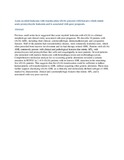Acute myeloid leukemia with translocation t(8;16) presents with features which mimic acute promyelocytic leukemia and is associated with poor prognosis

View/
Date
2013Author
Diab, A
Zickl, L
Abdel-Wahab, O
Jhanwar, S
Gulam, MA
Panageas, KS
Patel, JP
Jurcic, J
Maslak, P
Paietta, E
Mangan, JK
Carroll, M
Fernandez, HF
Teruya-Feldstein, J
Luger, SM
Douer, D
Litzow, MR,
Lazarus, HM
Rowe, JM
Levine, RL
Tallman, MS
Type
ArticleLanguage
enMetadata
Show full item recordAbstract
Previous small series have suggested that acute myeloid leukemia with t(8;16) is a distinct morphologic and clinical entity associated with poor prognosis. We describe 18 patients with t(8;16) AML, including their clinical, cytomorphologic, immunophenotypic and cytogenetic features. Half of the patients had extramedullary disease, most commonly leukemia cutis, which often preceded bone marrow involvement and six had therapy-related AML. Patients with t(8;16) AML commonly present with clinical and pathological features that mimic APL, with promyelocytes and promyeloblast-like cells and coagulopathy in most patients. Several patients also presented with marrow histiocytes with hemophagocytosis and erythrophagocytosis. Comprehensive molecular analysis for co-occurring genetic alterations revealed a somatic mutation in RUNX1 in 1 of 6 t(8;16) patients with no known AML mutation in the remaining five t(8;16) patients. This suggests that the t(8;16) translocation could be sufficient to induce hematopoietic cell transformation to AML without acquiring other genetic alteration. These data further support classifying t(8;16) AML as a clinically and molecularly defined subtype of AML marked by characteristic clinical and cytomorphologic features that mimic APL, and is associated with very poor survival
URI
http://www.ncbi.nlm.nih.gov/pubmed/23102703http://erepository.uonbi.ac.ke:8080/xmlui/handle/123456789/57955
Publisher
College of Biological and Physical Sciences ,Department of physics
